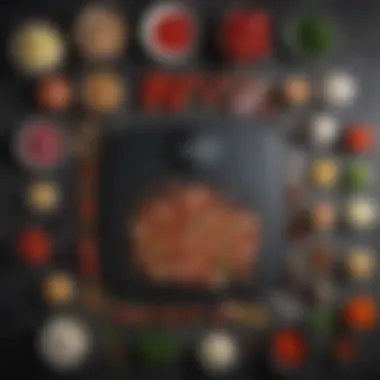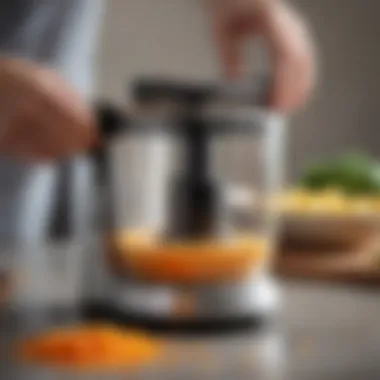The Ultimate Guide to Mini Chop Food Processors


Intro
Mini chop food processors are gaining popularity among home cooks and culinary enthusiasts. They save time and effort, providing efficiency in food preparation. These compact devices are specially designed to chop, dice, and mix ingredients with ease. The market is filled with various models, each offering different features and functionalities, making it crucial for buyers to understand their options.
In this guide, we will explore all aspects of mini chop food processors. From how they work to their benefits, you will learn everything necessary to make an informed decision. We will also discuss popular models in the market and provide maintenance tips. This resource aims to empower food lovers with knowledge to enhance their cooking experience.
Functionality and Benefits
How Mini Chop Food Processors Work
Mini chop food processors typically operate using a motorized blade. The user places ingredients in a bowl, secures the lid, and activates the machine. The blades spin rapidly, chopping the food into desired sizes.
Many models come with different speed settings, allowing for more control over the chopping process. This versatility is particularly useful for various recipes, from finely chopping herbs to coarsely mixing ingredients for salsa.
Advantages of Using Mini Chop Food Processors
Using mini chop food processors can significantly streamline cooking tasks. Here are a few key advantages:
- Time-Saving: Minimize prep time by quickly chopping vegetables or herbs.
- Consistency: Achieve uniform cuts for even cooking and presentation.
- Multifunctionality: Many models can also mix, blend, and puree, increasing their usability in the kitchen.
- Ease of Cleaning: Most mini chop food processors have detachable parts that are dishwasher safe.
"Efficiency in the kitchen can empower cooks to experiment with recipes that might otherwise seem daunting."
Key Considerations for Buying
When considering a mini chop food processor, here are important factors to keep in mind:
- Size: Ensure the model fits your storage space. Compact designs are advantageous for small kitchens.
- Power: Look for a processor with sufficient wattage for the types of tasks you wish to perform.
- Blade Quality: Stainless steel blades are preferred for durability and effectiveness.
- Ease of Use: Check user reviews for information on operation and maintenance.
Popular Models
Several models stand out in the market for their performance and reliability. Notable mentions include:
- Cuisinart DLC-2ABC Mini Prep Plus: Known for its versatility and efficiency.
- Hamilton Beach 72600: Budget-friendly yet effective for everyday use.
- Ninja BN701 Professional Plus Bender with Auto-iQ: Offers advanced blending and processing capabilities.
Maintenance and Care
Proper maintenance ensures longevity of your mini chop food processor. Here are practical tips:
- Regular Cleaning: Clean immediately after use to prevent residue buildup.
- Check Blades: Over time, blades can dull. Replace them as needed to maintain efficiency.
- Inspect Electrical Components: Ensure the motor and power cord are in good condition to avoid malfunction.
Understanding Mini Chop Food Processors
Understanding mini chop food processors is crucial for anyone looking to enhance their culinary skills or streamline their kitchen activities. These appliances have become a significant part of modern food preparation due to their ease of use and efficiency. They are perfect for home cooks who want to save time or for those who live in smaller spaces and require compact solutions for food processing. In this section, we will explore the definition and primary purpose of these tools, as well as how they differ from full-sized processors.
Definition and Purpose
Mini chop food processors are compact kitchen appliances designed for a variety of food preparation tasks. They are equipped to finely chop, dice, and puree ingredients, making them highly versatile. The primary purpose of these devices is to offer convenience and efficiency in food prep. Unlike larger food processors, mini chop processors are typically easier to handle and require less counter space. This can be beneficial for individuals who cook in smaller kitchens or need to process smaller quantities of food quickly.
"Mini chop food processors provide a perfect solution for those seeking efficiency in their culinary tasks."
Their design often includes simple controls, making them user-friendly for people of all skill levels. Some models even come with additional features such as pulsing options or specialized attachments which increase their functionality.


How They Differ from Full-Sized Processors
Mini chop food processors and full-sized processors serve similar functions but cater to different needs. The main difference lies in their size and capacity. Full-sized food processors can handle larger volumes and come with various attachments, suited for more complex culinary tasks such as kneading dough or slicing vegetables. In contrast, mini chop processors are tailored for quicker, smaller jobs—such as chopping herbs, making sauces, or preparing small portions of food.
The motor power in miniature models usually is less robust than that of their full-sized counterparts, impacting the types of tasks they can perform effectively. For example, a full-sized processor might handle raw carrots or dense nuts with ease, while a mini processor may struggle with tougher ingredients. Additionally, cleaning and storing mini processors is often less cumbersome; they can fit easily into drawers or cabinets and typically have fewer parts to maintain.
In short, mini chop food processors are designed to provide simplicity and convenience for everyday cooking tasks. They complement the more extensive, multi-functional food processors by excelling in efficiency for smaller jobs.
Key Features to Consider
When selecting a mini chop food processor, understanding key features is essential for making an informed decision. These features can influence the overall performance, usability, and satisfaction you derive from the product. Focusing on specific elements helps users find the right fit for their culinary needs.
Capacity and Size
Capacity is a primary factor in choosing a mini chop food processor. These appliances come in various sizes, often ranging from 2 to 8 cups. The size you choose should correspond with the typical volume of food you prepare. A smaller capacity is ideal for single servings or small family meals, while larger capacities can handle multiple ingredients at once. Understanding your cooking habits can help avoid frustration from under or over capacity.
- Consider your kitchen space. A compact size can save counter space while performing efficiently.
- Weight varies; some models are lightweight for easy handling, while others may be more sturdy which can be beneficial for stability during operation.
Motor Power
Motor power determines how effectively a mini chop food processor can handle different tasks. Generally, a motor with higher wattage translates to greater efficiency in chopping or pureeing tough ingredients. A range of 200 to 600 watts is common in mini models.
- Higher wattage is usually beneficial for making smoother blends or crushing harder foods, such as nuts and fibrous vegetables.
- Look out for noise levels. More powerful motors may produce more sound, which could influence your experience, especially if used in quieter settings.
Blade Material and Design
The blade material and design significantly affect the processor's performance. Typically, stainless steel blades are preferred due to their durability and efficiency. They should be sharp enough to evenly chop or blend ingredients without excessive effort.
- Choosing between different blade designs can be important. Some blades are better suited for chopping, while others specialize in blending.
- Removable blades can ease cleaning and maintenance.
Ease of Cleaning
Cleaning a mini chop food processor can sometimes be a tedious task. When selecting a model, pay attention to the design that facilitates maintenance. Look for units with dishwasher-safe parts, as this adds convenience.
- Smooth surfaces can make it easier to wash manually.
- A detachable bowl and blade can be helpful in terms of preventing food from getting stuck in crevices. Users should consider models that minimize the need for rigorous cleaning after each use.
A well-maintained processor not only lasts longer but also ensures consistent performance in your kitchen tasks.
In summary, understanding the capacity and size, motor power, blade material and design, and ease of cleaning provides significant insights when evaluating a mini chop food processor. These features directly impact functionality, user experience, and satisfaction.
Advantages of Mini Chop Food Processors
Mini chop food processors offer several advantages that make them appealing to both novice cooks and seasoned chefs. These compact machines bring unique benefits to food preparation while tackling tasks efficiently. Understanding these advantages can help potential buyers recognize how these tools can enhance their cooking experience.
Space Efficiency in the Kitchen
One of the most significant benefits of mini chop food processors is their space-saving design. In modern kitchens, where design often prioritizes aesthetics alongside functionality, having clutter-free countertops is essential. A mini processor occupies minimal counter space compared to traditional, larger models. This compactness becomes crucial for individuals who have limited kitchen areas or frequently move appliances for storage.
Moreover, many mini processors are designed to fit easily into cabinets or drawers. Their smaller size means they can be stored without hassle when not in use. This encourages more frequent usage, as users do not have to deal with the inconvenience of handling bulky tools. For college students, small apartment dwellers, and anyone aiming to optimize kitchen organization, these devices offer practical solutions.
Speed and Convenience for Small Tasks
Mini chop food processors are specifically designed for swift operations, making them perfect for small tasks. Tasks like chopping garlic, mashing avocados, or slicing herbs can be completed in just a few seconds. This speed significantly reduces preparation time in the kitchen, allowing users to focus on assembling their dishes rather than spending time on basic chopping or mixing.


Another convenience of these processors is their ease of operation. With straightforward controls and pre-set functions, even the less experienced cooks can navigate their use without confusion. The availability of one-touch features simplifies the cooking process further. As a result, users often find cooking less daunting and more approachable, which can foster a greater enthusiasm for home-cooked meals.
Versatility in Food Preparation
Versatility is a strong suit for mini chop food processors. These compact machines are capable of handling a variety of tasks that go well beyond chopping. Users can make sauces, dressings, or dips quickly and efficiently. For example, making a homemade pesto or blending a salad dressing requires minimal effort, giving even novice cooks the ability to create impressive flavor enhancers.
The ability to process various ingredients—from nuts to vegetables to soft cheeses—makes them useful for diverse culinary applications. Mini processors can also be beneficial for meal prep. They allow users to prep ingredients ahead of time, reducing cooking time during busier weeknights.
"The convenience and adaptability of mini chop food processors truly redefine how we approach meal prep"
In summary, mini chop food processors stand out for their space efficiency, speed, and versatility. Understanding these advantages informs better choices for potential buyers, enhancing their engagement with cooking.
Popular Applications in Cooking
When considering the value of a mini chop food processor, it is essential to explore its various applications in cooking. This section highlights how these compact machines integrate into everyday culinary tasks, providing benefits in terms of time, efficiency, and ease of use. Understanding specific applications can help readers appreciate the versatility and utility of mini chop food processors in their kitchens.
Chopping Vegetables
Chopping vegetables is one of the primary functions of a mini chop food processor. This function is particularly beneficial for those who may not have the time or inclination to chop ingredients by hand. With a mini processor, users can achieve uniformly chopped vegetables in a matter of seconds. This efficiency is especially valuable when preparing meals for large groups, where the volume of chopped vegetables required can be overwhelming.
Additionally, the even chopping can enhance the cooking process, allowing for more uniform cooking and flavor absorption. A mini processor can handle a range of vegetables, from soft tomatoes to harder carrots. For optimal results, it's advisable to cut vegetables into smaller pieces before placing them in the processor. This practice ensures the blades can easily slice through the ingredients.
Making Sauces and Dressings
Another popular application for mini chop food processors is the preparation of sauces and dressings. These devices enable precise blending of ingredients, resulting in smooth, well-mixed sauces that can elevate any dish. For instance, making a classic pesto or aioli becomes straightforward with a mini processor. Slow pouring of oil while processing further enhances texture and flavor, ensuring an emulsion that wouldn’t be so easy to achieve by hand.
In addition to convenience, utilizing a mini food processor for sauces allows for customization. Users can experiment with various ingredients, adjusting flavors and textures according to personal preference. Being able to blend herbs, garlic, and oils together quickly facilitates a pure, fresh alternative to store-bought options. The ease of clean-up after making sauces also encourages more frequent home cooking.
Preparing Dips and Spreads
Preparing dips and spreads is yet another common application for a mini chop food processor. Whether it’s hummus, guacamole, or a creamy yogurt-based dip, these appliances can blend various ingredients to create smooth and flavorful products. The versatility in creating different textures means users can produce chunky or smooth dips, tailored to personal taste.
Moreover, mini chop food processors allow for faster preparation and serving of snacks or appetizers. For parties or gatherings, it’s possible to whip up multiple dips in a short time. This not only saves preparation time but also enhances the overall dining experience by offering fresh, homemade options rather than relying on store-bought varieties.
By integrating a mini chop food processor into your cooking routine, you can save time and broaden your culinary repertoire.
In summary, the applications of mini chop food processors in cooking underscore their practical value. From chopping vegetables to making sauces and preparing enticing dips, these appliances simplify many aspects of food preparation, fostering creativity in the kitchen. Understanding these applications allows potential buyers to recognize the benefits of incorporating a mini processor into their culinary toolkit.
How to Use a Mini Chop Food Processor Effectively
Using a mini chop food processor effectively can enhance your cooking experience, simplifying tasks and saving time. These appliances are compact yet powerful, making them suitable for various food preparation tasks. Understanding how to operate it properly maximizes its benefits, ensuring you get the most out of this kitchen tool.
Step-by-Step Usage Guide
- Preparation: Begin by preparing your ingredients. Wash and chop larger items into smaller pieces to facilitate even processing. This reduces the strain on the motor and ensures thorough chopping.
- Assemble the Processor: Ensure that all parts of the processor are properly fitted. This includes the bowl, lid, and blades. Misalignment can affect performance and safety.
- Add Ingredients: Place the prepped ingredients into the bowl. Avoid overfilling, as this can lead to uneven chopping. Leave enough space for the blades to function effectively.
- Select Settings: Depending on the model, choose the appropriate speed setting. Many food processors come with options for pulse or continuous processing. Pulsing can give you more control over the final texture.
- Process: Secure the lid and start the processor. Monitor closely to avoid over-processing. For most ingredients, a few seconds to a minute is sufficient. Scrape down the sides if necessary to ensure all food is evenly chopped.
- Finishing Up: Once finished, turn off the processor and carefully remove the lid. Use a spatula to transfer the chopped food to a bowl. Clean the blades with caution, as they can be very sharp.
Common Mistakes to Avoid
- Overfilling the Bowl: Putting too much in the bowl can lead to poor results. Always check the maximum fill line.
- Ignoring the Pulse Function: This feature allows for better control. Don’t just run the processor continuously. Use pulses for finer chopping.
- Neglecting to Cut Large Items: Small chunks are easier to chop. Larger pieces can jam the blades and stress the motor.
- Not Cleaning Properly: After using the processor, ensure to clean it thoroughly to maintain hygiene and prevent any food residue buildup.
"Proper use and maintenance of your food processor not only extend its lifespan but also enhance your cooking skills."
Remember, with practice, you will learn the best techniques for using your mini chop food processor, allowing you to incorporate it seamlessly into your culinary routine. Understanding how to operate this device effectively ensures you can enjoy its benefits while avoiding common pitfalls.


Maintenance and Care
Proper maintenance and care of a mini chop food processor ensures its longevity and optimal performance. When we choose to invest in kitchen appliances, we naturally want them to function efficiently over time. Neglecting maintenance can lead to decreased performance, inefficient chopping, and even mechanical failures. Thus, understanding the best practices for maintaining your mini chop food processor is crucial for anyone who uses this kitchen tool regularly.
Proper Cleaning Techniques
Cleaning your mini chop food processor is simple but important. After each use, it is essential to disassemble the components, including the bowl, blades, and lid. Here are some effective cleaning techniques:
- Immediate Rinsing: Rinse the bowl and blades immediately after use. This helps prevent food residues from hardening, making cleanup harder later.
- Gentle Scrubbing: Use a soft sponge with warm soapy water to gently scrub all components. Avoid harsh materials that could scratch surfaces.
- Dishwasher Safe: Check the manufacturer's instructions. Many mini food processors have parts that are dishwasher safe, providing a convenient cleaning option.
- Blade Care: For stainless steel blades, simply wash and dry them right away. If they become dull, consider replacing them to maintain performance.
- Electrical Components: Wipe down the motor base with a damp cloth. Avoid getting water into any electrical components.
By following these cleaning techniques, you not only keep your mini chop processor in good condition but also ensure food safety.
Troubleshooting Common Issues
Despite careful maintenance, you may encounter issues with your mini chop food processor over time. Knowing how to address these problems effectively can save you both time and money. Here are some common issues and their solutions:
- Processor Not Starting: Ensure that it is plugged in correctly or that the lid is securely attached. The safety lock mechanism may prevent it from starting if these conditions aren't met.
- Inconsistent Chopping: If you find that the processor is not chopping evenly, verify that you are not overfilling the bowl. Furthermore, make sure the blades are sharp and check for any food particles stuck in the blades or bowl.
- Excessive Noise: Unusual sounds might indicate an issue with the motor or misalignment of parts. Disconnect, check the parts for any blockage, and reconnect.
- Leaking Ingredients: If fluid is leaking from the bowl, check if the lid is correctly sealed. An old or worn rubber gasket may also need replacing.
Addressing these common issues promptly can enhance the operational lifespan of your mini chop food processor, allowing it to serve you faithfully in the kitchen for many years. Remember, a well-maintained processor not only performs better but also enhances the overall cooking experience.
Evaluating Popular Brands and Models
Evaluating the popular brands and models of mini chop food processors is key for potential buyers. The market encompasses a variety of options, each offering distinct features, capabilities, and price points. Understanding these elements enables consumers to make informed decisions based on their specific needs and culinary preferences.
When one considers a purchase, factors such as reliability, performance, and customer support from brands are crucial. Selecting a well-regarded brand often correlates with quality assurance and durability. Poor choices can lead to dissatisfaction, which can waste both time and money.
In this section, we will discuss not only the top market choices but also provide a comparative analysis of their features to assist buyers in selecting the ideal mini chop food processor that meets their culinary demands.
Top Market Choices
There are several brands that have established themselves as leaders in the mini chop food processor category. Here are some notable options:
- Cuisinart: Known for its durable design and efficient performance, this brand offers various models that blend ease of use with effective chopping.
- Hamilton Beach: This brand is often recognized for its affordability and practical features, making it ideal for casual cooks.
- Ninja: Famous for powerful motors and versatility, Ninja's processors are suitable for those who want more than just chopping.
- Breville: Offers high-end models that focus on precision and design, appealing to more serious cooks.
- Oster: Recognized for good quality at a reasonable price, making it a reliable choice for many kitchens.
These brands not only provide robust machines but also cater to different budgets and requirements. When evaluating mini chop food processors, it is beneficial to consider what each brand uniquely brings to the table.
Comparative Analysis of Features
When comparing features, it's important to look at several aspects which can significantly affect the overall user experience. Here are key features to consider:
- Motor Power: A more powerful motor can handle tougher chopping tasks and can process ingredients more efficiently. For instance, Ninja models often boast higher wattage compared to other brands, which translates to better performance for difficult tasks.
- Blade Design and Material: Stainless steel blades are generally more durable and effective for chopping. Brands like Cuisinart offer finely constructed blades that ensure consistent results with every use.
- Capacity: Depending on the typical amount of food prepared, consumers should assess the bowl size. Some models are compact, while others offer larger capacities suitable for family meals.
- Ease of Use: Features like one-touch operation can be beneficial for quick processing tasks. Simple controls can drastically enhance user experience, particularly for beginners.
- Cleaning and Maintenance: Look for processors that offer dishwasher-safe parts to streamline the cleaning process. Some brands, like Hamilton Beach, emphasize ease of cleaning in their user manuals, making them a practical choice.
Evaluating these features allows potential buyers to narrow down their options based on personal cooking habits and kitchen requirements. By weighing the advantages and disadvantages of different brands and their models, consumers can ensure they make a wise investment in a tool that enhances their kitchen experience.
The End and Final Thoughts
Understanding the functionalities and advantages of mini chop food processors is crucial for anyone looking to enhance their culinary experience. This article has explored significant aspects such as their unique features, popular applications in cooking, usage best practices, and maintenance. Each of these elements contributes to a comprehensive understanding of how mini processors can optimize food preparation, making them indispensable for both amateur cooks and seasoned professionals. The ease of use and versatility offered by these appliances can transform daily cooking routines, ensuring efficiency without sacrificing quality.
Summary of Key Points
- Practicality: Mini chop food processors are designed for efficiency, ideal for small tasks like chopping and blending.
- Versatility: They assist in various cooking processes, from making sauces to preparing dips.
- Brand and Model Selection: Different models come with varying features, affecting capabilities and performance.
- Maintenance and Care: Proper care extends the lifespan of the processor, ensuring consistent performance.
Recommendations for Potential Buyers
When considering a mini chop food processor, buyers should evaluate several factors to make an informed decision:
- Capacity: Choose a size that fits your cooking needs. If frequently preparing small meals, a compact model may suffice.
- Motor Power: A more powerful motor handles tougher ingredients more effectively. Look for models with balanced power ratings.
- Ease of Cleaning: Select processors with removable, dishwasher-safe parts to simplify cleanup.
- User Reviews: Assess feedback from other users to understand performance reliability and customer service.
By carefully considering these elements, potential buyers can select a mini chop food processor that best fits their needs and enhances their culinary skills.







